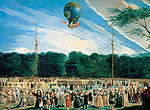
Antonio Carnicero
Encyclopedia

Spain
Spain , officially the Kingdom of Spain languages]] under the European Charter for Regional or Minority Languages. In each of these, Spain's official name is as follows:;;;;;;), is a country and member state of the European Union located in southwestern Europe on the Iberian Peninsula...
painter of the Neoclassic
Neoclassicism
Neoclassicism is the name given to Western movements in the decorative and visual arts, literature, theatre, music, and architecture that draw inspiration from the "classical" art and culture of Ancient Greece or Ancient Rome...
style.
Born in Salamanca
Salamanca
Salamanca is a city in western Spain, in the community of Castile and León. Because it is known for its beautiful buildings and urban environment, the Old City was declared a UNESCO World Heritage Site in 1988. It is the most important university city in Spain and is known for its contributions to...
on January 10, 1748 and died in Madrid
Madrid
Madrid is the capital and largest city of Spain. The population of the city is roughly 3.3 million and the entire population of the Madrid metropolitan area is calculated to be 6.271 million. It is the third largest city in the European Union, after London and Berlin, and its metropolitan...
on August 21, 1814. He was trained with his father, Alejandro Carnicero, a sculptor. He then traveled to Rome
Rome
Rome is the capital of Italy and the country's largest and most populated city and comune, with over 2.7 million residents in . The city is located in the central-western portion of the Italian Peninsula, on the Tiber River within the Lazio region of Italy.Rome's history spans two and a half...
and returned to be named chamber painter for King Charles III of Spain
Charles III of Spain
Charles III was the King of Spain and the Spanish Indies from 1759 to 1788. He was the eldest son of Philip V of Spain and his second wife, the Princess Elisabeth Farnese...
. He also worked as an engraveor. He illustrated an edition of Don Quixote.
Son of sculptor Alexander Carnicero, went to the court of Madrid in 1749 by Felipe de
Castro with his father whom he had commissioned a series of sculptures for the royal
apartments. He was also a painter his brother Isidro Carnicero. He entered the Royal
Academy of Fine Arts of San Fernando in 1758 and twelve years he was a scholarship
from the Academy to go along with his brother Isidro to expand their study of painting in
Rome.
In 1766 he returned to Madrid where he began to paint for civil and religious institutions,
private clients and then working for the Royal Household since 1775 with Joseph del
Castillo in the execution of tapestry cartoons. He also worked as a decorator theatrical
performances for the Theatre de la Cruz and the Teatro del Principe documented in
1885.
Highlighted as a draftsman and printmaker. Their ability is revealed by the series of
colorful costumes Spain and the Indies (1777), his series of etchings on bullfighting
(1790) or the portraits of illustrious Spanish (1788). He participated with his prints on the
editorial project of the Language Academy prepared a deluxe printing of Don Quixote,
which was edited by Joaquín Ibarra in 1780 and 1782, and was a milestone in the
ultimate edition of the classic Spanish literature .
He obtained a great result with the work the coronation of King Alfonso XI and Queen
Mary, his wife in the competition held to decorate the church of San Francisco el
Grande in Madrid. In 1783 or 1784 illustrating reporter becomes a Montgolfier
Ascension in Aranjuez, which may reflect two events: one dated June 5, 1784, in which
the French Bouclé balloon rose into the gardens of Aranjuez in the presence of the
court and the people dressed in nice people, or another that occurred on November 23,
1783 in El Escorial, starring the Marquis d'Arle and pilasters Rozier.
Painter reyEn chamber 1796, and after several failed attempts in 1788, 1792 and
1793, Carnicero was appointed painter to the King, working since then mainly as a
portraitist of the royal family and other justices-portraits Manuel Godoy young or Pedro
Rodríguez de Campomanes, and as a painter of tapestry cartoons.
He taught drawing the infants of the royal family, especially the then Prince of Asturias
Fernando VII. The relationship with Prince Carnicero drew on suspicion of being involved
in the so-called conspiracy of the Escorial in 1806 led Fernando to dethrone his father,
to the point of being arrested on November 7, 1807 remained more than ten days in this
situation until it was released.
From 1809 he was forced, like Francisco de Goya, to work for Joseph Bonaparte to
keep his position as Painter. A butcher Antonio Aragon, unlike it was initiated a process
to be removed from office on the ground that he had served the King abroad. The
request for appeal Carnicero came too late to be reinstated to his position, since he died
on August 21, just days before the amnesty proclaimed by Ferdinand VII in 1814.

